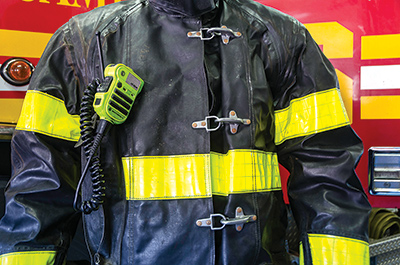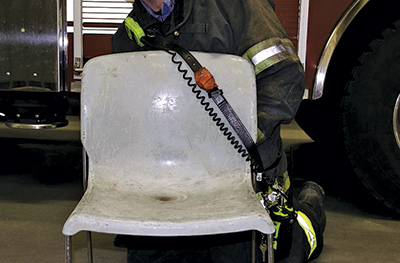
BY DANNY STRATTON
View Image Gallery>>
Wearing your portable radio properly is important to protect the device and maintain your ability to operate it effectively during interior firefighting. Using a leather radio strap and case and wearing both under the turnout coat is the best way to do this.
Outside the Coat
Placing the radio strap over the coat exposes the entire unit to heat damage, particularly the wire between the microphone and the radio. Furthermore, if worn outside the turnout coat, the strap and the radio wire are more likely to become entangled with furniture, stock, and wiring inside a fire structure, possibly detaching the microphone and entrapping the firefighter (photos 1-3).

If you carry the device in your turnout gear or radio pockets, you may encounter problems securing and protecting it from exposure. The entire wire is vulnerable to heat and fire damage and can become entangled. Another problem, mentioned in the Fairfax County (VA) Fire & Rescue study, “Portable Radio Placement in the IDLH”( http://bit.ly/1dIdN1T), is that portable radios tend to fall out of the radio pockets when a firefighter crawls on the ground or bends over.
Keeping the wire and the leather strap underneath the coat secures them and avoids entanglements. Also, the radio is less prone to moving around freely than if you wear it over your turnout coat. Only the part of the radio that protrudes from the bottom of the coat is vulnerable.
View Image Gallery>>
Wearing Tips
Here are some tips for wearing the radio and the carrying harness under the coat for efficient operation. The strap should be long enough, but not too long, for a person of your size. The radio and case should protrude just below the coat (photo 4). Putting the antenna and radio under the coat inhibits transmission and reception. The antenna should clear the bottom of the coat, which should not come in contact with any radio control knobs.
I once had a problem with my volume control somehow getting turned down while I was operating. I fixed the problem by getting a longer strap. However, if the assembly hangs too low, it can become easily entangled on objects below.

The Fairfax County Fire & Rescue study recommends you keep the portable radio upright at all times for maximum signal transmission and reception. The radio in the harness and on the strap will naturally tilt upright when a firefighter kneels down or crawls (photo 5).
View Image Gallery>>
The Microphone
The microphone usually hangs outside your protective apparel at the top of the coat, usually above the uppermost part of a zipper, a latch, or a button and under the collar attachment. This provokes criticism for breaching of the bunker coat and compromising the personal protective equipment (PPE) envelope (photo 6).
Use the turnout jacket’s zipper, the latches, the hook-and-loop fastener, and the flash hood to envelop the wire for a close, snug fit; it can be done. The garment under your turnout coat should be 100-percent cotton, which will be more than enough to protect you from burns. Chances are that if the coat fails and compromises the wearer, it will most likely be at the arms instead of the torso area. Furthermore, if a firefighter is burned while wearing full protective gear, the areas more typically affected are the face, the head, the neck, the hands, the ears, the knees, and the legs-not the torso. However, if a firefighter is not proficient in correctly donning the coat and radio, heat waves and steam can find their way into the coat, so practice and become proficient in properly donning your PPE.
Although you can use a clip to attach the microphone to the coat, where the wire emerges from the top of the coat, I advise against it. If it is stationary, it will be like clipping the microphone onto the radio strap. The push-to-talk button is more prone to accidental activation and the possible interruption of important transmissions, particularly if the mic key is not recessed (photo 7). If you allow the transmitter to hang out of the gear by the wire instead, it will swing like a pendulum when it comes in contact with another object, which will keep the microphone from being accidentally keyed (photo 8).
Which shoulder the strap should hang on depends on your preference. However, if you carry a portable light or, more critically, have an escape system bag or a gear pants pocket equipped with an escape device, that can determine on which side you will wear the radio strap. A portable light, a radio, and an escape system bag hanging on the same hip or waist area can be cumbersome.
View Image Gallery>>
Whichever shoulder you use, the radio will hang out on the side opposite of the escape system bag, such as a hip bag or lumbar bag, which may be attached to an escape belt. Portable lights usually have shorter straps, so they tend to sit higher. Therefore, whichever shoulder the strap hangs on, it must clear the radio or the escape bag. If choosing a different placement for your equipment, be sure it doesn’t hinder your access to the opening of the bag or gear pants pocket in a moment of haste (photo 9). You will have to adjust the gear based on your height.
I don the turnout suspenders over my shoulders before the radio strap. The radio may slide to various positions under the coat. While wearing a jacket, a self-contained breathing apparatus, and other equipment strapped to your torso, you can move the radio back and forth to negotiate entanglements, perform a reduced-profile maneuver to fit through a tight area, and change channels or manipulate the volume control. If you do not want the radio to move at all, you can use an anti-sway strap that connects the leather holster to your pants under your turnouts.
Using a leather radio strap underneath a personal protective fire coat is the best option for wearing the radio and the carrying system. This arrangement keeps the radio and its components from creating a firefighter emergency such as an entanglement or heat/flame impingement that renders the device useless. It’s a better option than the over-the-coat method or using a radio pocket. Apply these tips, practice wearing the strap under the jacket, and make adjustments as needed to enhance your ability to operate in an immediately dangerous to life and health (IDLH) atmosphere.
View Image Gallery>>
Reference
1. “Portable Radio Placement in the IDLH.” Fairfax County Fire & Rescue Department Communications Section, 1-2013, http://bit.ly/1dIdN1T.
DANNY STRATTON is a 27-year fire service veteran and a captain with the Camden City (NJ) Fire Department. He has served as a firefighter in the volunteer and career fire service and the United States Army. Stratton is a course coordinator at the Camden County Emergency Training Center and an instructor for Safety and Survival Training LLC. He is a rescue specialist with NJ-TF1 and has two associate degrees in fire science.
Related Links
FIREFIGHTER SAFETY AND RADIO COMMUNICATION
THE IMPORTANCE OF MAYDAY/URGENT RADIO GUIDELINES
IMPROVING FIREGROUND RADIO COMMUNICATIONS
Digital vs. Analog Radio Systems
Fire Engineering Archives

